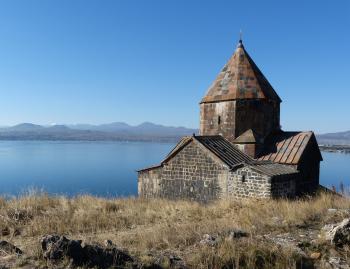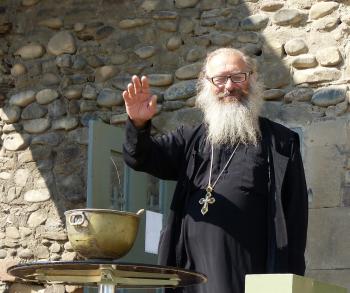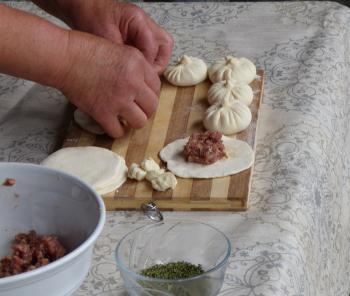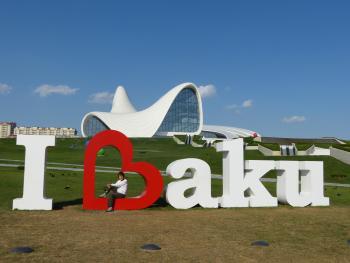Mountains, monasteries and museums – a guided tour of the Caucasus
This article appears on page 6 of the April 2017 issue.
Claire Prest, our ElderTreks tour leader, posed a question as we gathered on day one of our 20-day Caucasus itinerary: “Who can name all the countries in the former Soviet Union?”
The rest of the group applauded as one of our group members quickly rattled off all 15: “Russia, Ukraine, Uzbekistan, Kazakhstan, Belarus, Azerbaijan, Georgia, Tajikistan, Moldova, Kyrgyzstan, Lithuania, Turkmenistan, Armenia, Latvia and Estonia.
We’d be visiting only three — Azerbaijan, Georgia and Armenia, all belonging to the region known as the Caucasus — on this September 2016 tour, on which I was a guest of ElderTreks.
An introduction
“Where is the Caucasus?” was the usual head-scratching response I heard when friends inquired where I’d be traveling next. Not surprising, for it was a question that had me scurrying to the Internet when I first came across the offering in ElderTreks’ wish book of trips.
There I learned of the mighty Caucasus range that includes among its peaks Mount Elbrus, which, at 18,510 feet, is the highest in Europe. Stretching between the Black and Caspian seas, the range forms the dividing line (geopolitically) between Eastern Europe and Western Asia, with Azerbaijan, Georgia and Armenia claiming footholds along its length.
Azerbaijan, on the “Asian” side of the Caucasus, has followed Shia Islam since the 16th century; Georgia and Armenia, on the “European” side, date their dedication to the Orthodox Christian church to the early fourth century.
Our tour began in Azerbaijan, moving on to Georgia on day six for a week of exploration before spending our final week together in Armenia.
Of the three countries, Azerbaijan was the only one that required a visa ($20), a paperwork-and-passport process eased by ElderTreks’ assistance.
Arriving in Azerbaijan
ElderTreks, based in Toronto (800/741-7956; eldertreks.com), specializes in adventures for travelers aged 50-plus. The Caucasus marked my fourth trip with the company (Ethiopia, Aug. ’07, pg. 6; Iran, July ’09, pg. 24, and Southern Africa, Oct. ’14, pg. 6). On each, I applauded ElderTreks’ dedication to small-group travel. On my previous trips, groups ranged from eight participants to 14; the head count for this trip was only five.
Lufthansa flights from San Francisco, my home-base airport, delivered me, via Frankfurt, to Baku’s Heydar Aliyev International Airport. Stepping outside the terminal, I was dazzled by a multistoried building-turned-gigantic-wedding cake courtesy of zillions of little white lights. And there was more to come.
Passing the floodlit latticed walls that lined the highway, we reached the city. Move over, Hong Kong and Tokyo! Baku’s array of architectural wonders, constructed courtesy of revenue generated by the Caspian Sea’s oil-rich pools, were showcased in such razzle-dazzle color that it took my breath away.
It was a performance not repeated during the duration of our stay, save for the architectural trio known as Flame Towers, bathed in changing, fire-like color, and the floodlit Maiden Tower, the Old City’s historical icon.
Questioning the concierge at the Hilton Baku, I learned the full-fledged light show occurs only on special occasions or to celebrate the arrival of an important someone — on this occasion, most likely in honor of those arriving to participate in the 42nd Chess Olympiad, which had turned the hotel’s lobby, and presumably every other hotel lobby in town, into a sea of the world’s diverse ethnicities.
Europe seemed closer than Asia while I strolled Baku’s leafy boulevards. Beaux-Arts mansions remind that Azerbaijan’s first oil boom occurred over a century ago. Today, designer boutiques occupy many of those same classic buildings. Tiffany, Gucci, Dior — the global high-fashion gang was all there.
Baku sights
Toghrul Baghirli, with long family ties in Baku, was our local guide throughout our jam-packed days in Azerbaijan.
In Baku, in the Flame Towers area, we walked along a somber alley of martyr graves, each touchingly displaying a photograph of the person memorialized. A flame burns eternally at the end of the alley in a marble-paved overlook of panoramic sea and city views.
We also took in the city’s contemporary architectural wonders, ranging from the space-age waves of the cultural center (the Heydar Aliyev Center), the work of recently deceased acclaimed architect Zaha Hadid, to the Azerbaijan Carpet Museum, designed to look like a rug caught in the act of unrolling.
Inside the Old City’s fortified 12th-century walls, we walked a maze of lanes past 15th-century honey-colored sandstone buildings to the Palace of the Shirvanshahs, seat of Azerbaijan’s ruling dynasty in the Middle Ages.
In 2003, the entire complex was painstakingly restored and a small museum added. Among the items on display was an ornately embroidered “mustache keeper,” to insure the shah would greet the morning well groomed.
Lunch was at a caravanserai-turned-restaurant in an alcove where camels once munched. It was the first of a number of Silk Road caravanserai we’d encounter in the Caucasus. Among them, the most memorable experience was our flashlight exploration of a 1332-constructed caravanserai left “as was” — not turned into a restaurant, hostel or gift shop emporium — in its remote location near the summit of Armenia’s Selim Mountain Pass (now known as the Vardenyats Mountain Pass).
Outside Baku, we followed the Absheron Peninsula oil road through a semidesert landscape that included a centuries-old “flaming hillside” of spontaneously burning natural gas, mentioned by Marco Polo in his 13th-century writings, and a host of derelict and active oil rigs on land and floating platforms in the Caspian Sea.
Our destination, the Gobustan Reserve, is UNESCO-listed for its more than 6,000 petroglyphs reflecting intensive human habitation from the Upper Paleolithic to the Middle Ages. Exhibits at the new, state-of- the-art museum there revealed that, at the time the stone engravings were created, the now-stark peninsula was lushly verdant.
Paths took us through caves and rock formations to view Gobustan’s array of stick-figure art carvings depicting the activities of humans and animals during that time.
Road trips
ElderTreks’ Caucasus itinerary description alerted participants to expect long drives in all three countries over, often, rough roads. I delighted in the road trips as opportunities to take in the dramatic, ever-changing scenery and observe, albeit from a van window, the subsistence existence of those living outside urban centers. The local guides traveling with us provided cultural insights and information along the way.
An almost-all-day road trip, with ample leg-stretching stops, took us to Sheki, one of Azerbaijan’s most ancient and picturesque cities.
Sheki’s 18th-century summer palace of the khans delighted with its exquisite floral paintings that covered every surface, including the ceilings. Colored light poured through stained-glass windows, called shabaka.
A short walk away, Resulov Tofig awaited at his master shabaka workshop ready to demonstrate the fitting of fragments of glass into small, hand-carved wooden frames, a process unchanged through the centuries.
A different delight was the Saturday market, its stalls abundant in fresh produce, squawking poultry and bags of spices. I purchased a scoop of purple-red sumac, handed over to me in a paper container constructed on the spot.
At every meal in Azerbaijan, sumac was present on the table, a dash of which could be sprinkled on for tartness.
While the three countries shared culinary similarities, certain dishes from each linger in my taste-bud memory. In Azerbaijan, teeny grape leaf-wrapped dolmas, filled with minced lamb and served in a sauce enriched with prized lamb-tail fat, was presented in individual clay pots to be scooped out and dolloped with yogurt.
In Georgia, khinkali, dumplings filled with minced meat, were the stars; avoid making a mess by taking a nip out of the side and sucking out the accumulated meat juices before enjoying the rest.
In Armenia, sterlet, a small species of sturgeon, was grilled and chopped crosswise into serving-size pieces and topped with fresh herbs. It was so delicious that it erased from my mind that sterlet is an exceptionally ugly fish.
On to Georgia
Borders were easily crossed with the assistance of Claire and the awaiting local guide. Each crossing involved a change of currency and a new learning curve for those who had become proficient in “Hello,” “Goodbye” and “Thank you” in the previous country’s language.
“Welcome to the land of churches,” Claire announced as she introduced us to Nene Somnashili, our Georgian guide. That could equally have been said when we crossed the border into Armenia, with its centuries-old dedication to the Apostolic Christian faith equal to that of Georgians to the Orthodox church.
In both countries, each day’s travel included visits to churches and monasteries located on mountain peaks, in rugged canyons, overlooking bodies of water, carved into the stone faces of steep cliffs or tucked into the old centers of the two countries’ capital cities. Some were memorable for the stories behind their existence or the frescoes and icons within and others for the beauty of their settings and architecture or the experience of unexpectedly stepping into a service under way.
That said, our first stop was a winery.
Georgia’s wine history, one of the oldest in the world, dates back 8,000 years. Given that, at our stop at Chelti Winery, located in the Kakheti region, I was initially disappointed to be led through a winery that differed little from the countless stainless-steel, state-of-the-art facilities I’d walked through in California. But a separate building housed a surprise, a large room filled with what looked like manholes edged in brick.
Unique to Georgia, the large, clay vessels known as qvevri are buried in the ground, where the wine is aged at the temperature of the earth.
Seated at a table in the winery’s courtyard, we sampled wines paired with dish after dish of beautifully prepared and presented Georgian cuisine. Following Georgian hospitality, the table was soon piled with food, as no serving dish is to be removed until the meal is done, in case someone might want seconds or thirds.
Soviet reminders
While city-centered hotels housed us for most of our 3-country journey, one exception was a family-owned guest house in the town of Telavi, where we stayed overnight.
The stay gave us a jump start on a long drive we would take through a starkly beautiful lunar-like landscape to Davit Gareja, a remote complex of 19 monasteries carved into stone cliffs.
While rooms at the guest house were distinctively basic — think bare lightbulb hanging from the ceiling — we were warmly greeted and abundantly fed, reflecting the Georgian proverb “Every guest is God sent.”
En route to Davit Gareja, Nene spoke of what life was like under Stalin’s Soviet rule. “Our culture, customs, language and religion were all taken away,” she said.
“Taken away but not erased,” she continued. “When the Soviets abruptly left in 1991, times were hard. We had weeks without electricity and gas, and food was scarce.” Nene, only four years old at that time, summed it up with, “I don’t know how we survived.”
Survive they did, quickly reintroducing the pillars of life held dear.
During one day’s itinerary that took us through the ruggedly picturesque Borjomi Gorge, we paused in Gori, Josef Stalin’s birthplace, with its central square devoted to his life and times.
A glass-roofed structure reminiscent of a Doric temple protected the 2-room house where he was born. The elegant railcar in which Stalin traveled sat adjacent. Both were adjuncts to the museum, a grand Italianate-style palazzo.
Multiple rooms displayed photos, documents and memorabilia relative to his life, from childhood to death. Missing was mention of the harsh realities of his time in power.
That was found at the Museum of Soviet Occupation, located on the top floor of the Georgian National Museum in Tbilisi, Georgia’s capital city. Copious exhibits documented the brutality of Soviet repression, under which 80,000 Georgians were shot and 800,000 were deported from 1921 to 1991.
Tbilisi charmed with its maze of cobblestone lanes twisting through Old Town, many lined with sidewalk cafés.
We stopped at the seventh-century Sioni Cathedral, stepping inside in time to hear a service, with a choir of six women responding in Georgian polyphonic harmony. Like qvevri, Georgian polyphonic singing is included on UNESCO’s Intangible Cultural Heritage list.
Leaving Tbilisi, we followed the Georgian Military Highway, winding high into the mountains on this spectacular route that has existed since the first century and remains today as an entry road into Russia. Along the way, we stopped at the elaborate Svetitskhoveli Cathedral complex in Mtskheta where, it is said, the robe of Jesus is buried.
We overnighted at the Gudauri ski resort, an unplanned mishmash of built and half-built hotels serviced by a forlorn market and petrol station, making me wonder how it could be that the descendants of those with the ability to design and construct fabulous monastery and church complexes centuries ago could make such a mess of a ski resort.
Next on our itinerary was Trinity Church, remotely situated on a mountaintop above the town of Gergeti. Piling into jeeps, we embarked on a looping, rough-road drive that delivered us to a parking spot. From there, a steep path took us to the walled grounds of the 14th-century church.
Even on this drizzly day, the setting was glorious, with the backdrop of Mount Kazbegi (Kazbek) appearing and disappearing in the mist.
On our return trip, there was much to see and do. Especially memorable was clambering about the cave city of Vardzia, sculpted into the side of Erusheti Mountain. Constructed for Queen Tamar, who reigned during the apex of Georgia’s 12th-century Golden Age, more than 400 rooms, 13 churches and 25 wine cellars have been uncovered, and archaeologists continue to unearth more.
Quite different was the remote, tiny alpine village of Phoka, where, in 1992, a small cadre of nuns founded a nunnery. There they produce professionally packaged jams, chocolates, honey and other products, including 15 kinds of cheese and exquisite cloisonné enamelware. While the shoppers among us were delighted with the small shop displaying their wares, Tbilisi’s upscale gift shops are the nunnery’s major market.
Lunch, arranged for us in advance, showcased the nuns’ culinary talents.
Entering Armenia
We bade good-bye to Nene at the Georgia-Armenia border and greeted Irina Istvatsaturyants, our guide through Armenia’s wealth of ancient churches, monasteries and more.
Lake Sevan, one of the largest alpine lakes in the world, was our first destination. We overnighted on the west (resort) side of the lake, again, a mishmash of nonplanning.
Leaving the next day, we enjoyed lake and mountain vistas as we traveled along the undeveloped eastern side of the lake. Fishermen sold their catches by the side of the road, and beekeepers kept watch over their clusters of hives. We pulled over to gather handfuls of sea buckthorn berries that, Irina told us, are considered a ”medical berry” for curing whatever might ail you.
The long road-trip day took us over Selim Pass on a winding, high mountain road, our driving pace frequently determined by flocks of sheep and herds of cattle sauntering ahead.
Among our stops was the megalithic stone structures of Karahunj, 3,500 years older than Stonehenge and considered by some archaeoastronomers to be an observatory.
To reach Tatev Monastery, founded in the ninth century and listed among Armenia’s most important medieval universities, we stepped aboard a cable car that would transport us 3½ miles in 12 minutes, shortening considerably the otherwise-arduous journey to reach the monastery, located on the edge of a gorge far below.
Yerevan
After an overnight in the small town of Goris, we continued to Yerevan, Armenia’s capital city, where we would headquarter for our trip’s final days.
Included in our stops en route was Khor Virap, meaning “deep hole,” so named for the cell where St. Gregory the Illuminator was held for more than a dozen years, an incarceration that resulted in Armenia’s becoming, in the year 301, the first officially declared Christian nation in the world. Considered a place of pilgrimage, Khor Virap looks directly across at snowcapped Mt. Ararat, where, it is said, Noah’s Ark came to rest.
We stopped, too, at the first-century Hellenic-style temple at Garni, a symbol of pre-Christian times, and Geghard Monastery, with its series of chapels hand-hewn into the side of a mountain. Acoustically perfect, by design or accident, the chapels are a favored concert venue, one that was taken advantage of by a women’s choir that day.
After reaching Yerevan, we settled into our hotel located steps away from Republic Square, the city’s main square, designed as a major focal point for the Soviets’ 1924 rebuilding plan to create a classic European city.
While in Yerevan, we ventured out of the city to visit Etchmiadzin, the “Vatican” of the Armenian Apostolic Church, stopping as well at the cathedral’s treasury and the once-buried church of St. Gregory at Zvartnots, where Irina had arranged for us a performance by a trio from Yerevan’s opera among the excavated ruins.
Yet, undeniably, the highlights of our Yerevan stay were the city’s museums.
The Armenian Genocide Museum-Institute told the story of the Ottoman Empire’s systematic massacre of Armenians, from 1915 to 1922, through exhibits of photographs, documents, newspaper reports and films. In its setting, architecture and means of telling the story, it was every bit as heart-rending and sobering as Jerusalem’s Holocaust Museum.
In a large building on Republic Square, the History Museum of Armenia astounded with its collection of Bronze Age artifacts, many excavated near Lake Sevan in the 1950s. Enormous earthenware vessels looked as if they had been fabricated the day before. An intact wooden cart with wooden wheels, which had been placed in a burial site to provide transportation for the deceased into the afterlife, looked ready to roll. The oldest-known leather shoe, complete with laces — surprisingly au courant at 5,500 years old — looked to be about my size.
But it was the Matenadaran, the world’s richest repository of ancient manuscripts, that illustrated the importance of the many medieval monasteries and churches we’d visited along the way. Beyond religion and gospel, the topics covered in the documents included history; botany and botanical medicinal recipes; mathematics; astronomy; the musical notation used still in Apostolic churches; poems, and a surprising love letter — a collection of more than 100,000 objects.
My mind’s eye turned to those monks who painstakingly penned on vellum by candlelight. Did they have any idea that what they were recording might possibly be on view and of incredible value centuries hence?
My tour of the Caucasus — with its churches and monasteries but so much more — is a trip I’ll long remember.
Yvonne Michie Horn was a guest of ElderTreks for the land portion of the tour. The 2017 Caucasus tour is priced at $6,895 per person, double, including all meals, entry fees and gratuities (with the exception of any gratuity for the ElderTreks’ guide).





